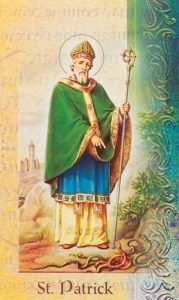
The Feast Day of St. Patrick is ~ March 17th
St. Patrick, the great apostle and patron of Ireland, was the son of Calpurnius, a Roman Decurio in Brittany (Britain), and through his mother was closely related to St. Martin of Tours. At 16, he was carried off by some Irish raiders into captivity, whereby he spent the next 6 years as a shepherd in the service o the chief Milch in Dalaradia (Antrim) before he was able to escape and make his way to Brittany and the monastery of Tours. His spiritual understanding and prayer life having meanwhile developed greatly, he longed to instruct the pagan Irish in the faith, but some 20 years were to pass before he would return to them in the official capacity of a missionary.
The British Bishop Palladius was sent to Ireland by Celestine I in 430 “to the Scots who believe in Christ”, but the hostility he encountered at the hands of the pagans compelled him to return to England where he died soon after. Thereupon Patrick, then in his forties, was consecrated Bishop and commissioned to evangelize the land of his one-time captors. He too was at first driven back to his ship by the Druids; but landing further North, he converted the chieftain Dichu by a miracle and dedicated the first Christian sanctuary at a place called Sabhall (Saul)
When some years later, all chiefs had assembled at the hill of Slane near Tara, Patrick seized the opportunity to expound the faith boldly, using the “shamrock” to illustrate the doctrine of the Holy Trinity. One stem, three leaves; one nature, three persons, was the core of his preaching. The enraged Druid Priests demonstrated their demoniacal powers by levitation, e.t.c,but when Patrick’s prayer was able to bring them to naught, King Leoghaire gave him permission to teach Christianity throughout the isle. It was at this point of time that the Saint composed the magnificent hymn we call “St. Patrick’s Breastplate”.
Patrick spent 7 years in the zealous evangelization of Connaught and then wandered through Ulster, Meach, Leinster and Limerick working numerous miracles. He and his companions were thrown into prison numerous times even threatened with death, but in the end his success was astounding, chiefs and common people coming into the fold by the thousands.
The Pope sent him three auxiliary Bishops in 461 and two years later, Patrick went to Rome to report his work to His Holiness. Upon return, he kept on travelling about Ireland, organizing parishes and the diocese with a native clergy and before long there also sprang up a number of convents and monasteries – the training schools for those later Saints who contributed so greatly to saving the faith in Europe.
Humble, yet courageous, Patrick’s determination to accept the suffering and success with equal candour guided him in winning most of Ireland for Christ. Indeed by the time he died at Sabhall in 461, he had established the church in Ireland on a truly solid foundation. So rapid and thorough had been the country’s conversion, that within 10 years of his landing he had been called upon to aid in the revision of its laws on a Christian basis.
Until his very end, this great man of prayer never relaxed his penitential exercises and mortifications. As for his indisputably genuine writings that have come down to us, his “Confessio” and his “Epistola Coroticum” deserve to be more widely known and appreciated, for they reveal God’s wonderful and providential workings in and through this great soul.
Reflection: “God’s hand for my cover,
God’s path to pass over.
God’s buckler to guard me,
God’s army to ward me” (St. Patrick Breastplate)
